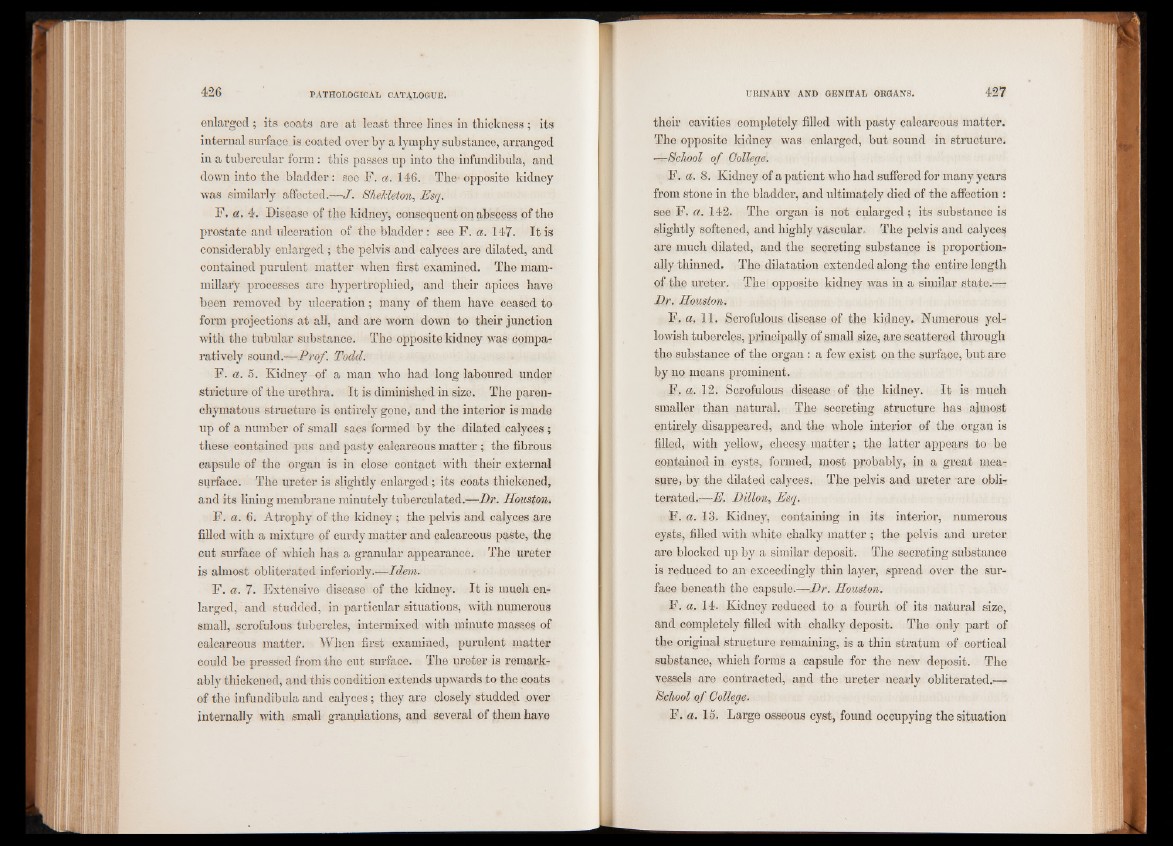
enlarged ; its coats are at least three lines in thickness ; its
internal surface is coated over by a lymphy substance, arranged
in a tubercular form : this passes up into the infundibula, and
down into the bladder: see F. a. 146. The- opposite kidney
was similarly affected.—J. SheJcleton, Esq.
F, a. 4. Disease of the kidney, consequent on abscess of the
prostate and ulceration of the bladder : see F. a. 147. It is
considerably enlarged ; the pelvis and calyces are dilated, and
contained purulent matter when first examined. The mammillary
processes are hypertrophied, and their apices have
been removed by ulceration; many of them have ceased to
form projections at all, and are worn down to their junction
with the tubular substance. The opposite kidney was comparatively
sound.—Prof. Todd.
F. a. 5. Kidney of a man who had long laboured under
stricture of the urethra. It is diminished in size. The parenchymatous
structure is entirely gone, and the interior is made
up of a number of small sacs formed by the dilated calyces ;
these contained pus and pasty calcareous matter ; the fibrous
capsule of the organ is in close contact with their external
surface. The ureter is slightly enlarged; its coats thickened,
and its lining membrane minutely tuberculated.—Dr. Houston.
F. a. 6. Atrophy of the kidney ; the pelvis and calyces are
filled with a mixture of curdy matter and calcareous paste, the
cut surface of which has a granular appearance. The ureter
is almost obliterated interiorly.—/«fern.
F. a. 7. Extensive disease of the kidney. It is much enlarged,
and studded, in particular situations, with numerous
small, scrofulous tubercles, intermixed with minute masses of
calcareous matter. When first examined, purulent matter
could be pressed from the cut surface. The ureter is remarkably
thickened, and this condition extends upwards to the coats
of the infundibula and calyces; they are closely studded ever
internally with small granulations, and several of them have
their cavities completely filled with pasty calcareous matter.
The opposite kidney was enlarged, but sound in structure.
-r-Scliool of College.
F. a. 8. Kidney of a patient who had suffered for many years
from stone in the bladder, and ultimately died of the affection :
see F. a. 142. The organ is not enlarged; its substance is
slightly softened, and highly vascular. The pelvis and calyces
are much dilated, and the secreting substance is proportion
ally thinned. The dilatation extended along the entire length
of the ureter. The opposite kidney was in a similar state.—p
Dr. Houston.
F. a. 11. Scrofulous disease of the kidney. Numerous yellowish
tubercles, principally of small size, are scattered through
the substance of the organ : a few exist on the surface, but are
by no means prominent.
F. 12. Scrofulous disease of the kidney. It is much
smaller than natural. The secreting structure has almost
entirely disappeared, and the whole interior of the organ is
filled, with yellow, cheesy matter; the latter appears to be
contained in cysts, formed, most probably, in a great measure,
by the dilated calyces, The pelvis and ureter are obliterated.—
E. Dillon, Esq.
F. a. 13, Kidney, containing in its interior, numerous
cysts, filled with white chalky matter ; the pelvis and ureter
are blocked up by a similar deposit. The secreting substance
is reduced to an exceedingly thin layer, spread over the surface
beneath the capsule.—Dr. Houston.
F. a. 14. Kidney reduced to a fourth of its natural size,
and completely filled with chalky deposit. The only part of
the original structure remaining, is a thin stratum of cortical
substance, which forms a capsule for the new deposit. The
vessels are contracted, and the ureter nearly obliterated.—
School of College.
F. a. 15. Large osseous cyst, found occupying the situation